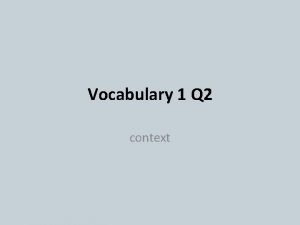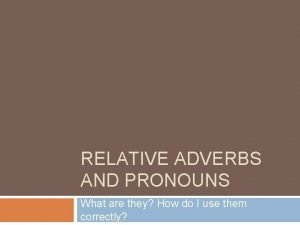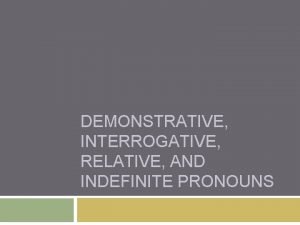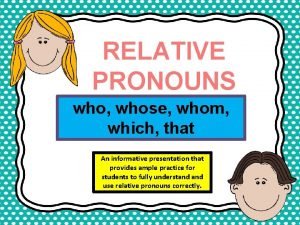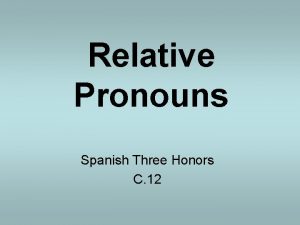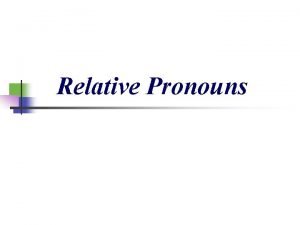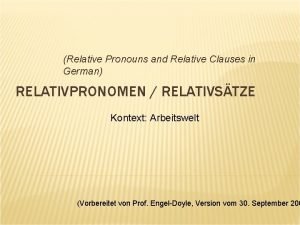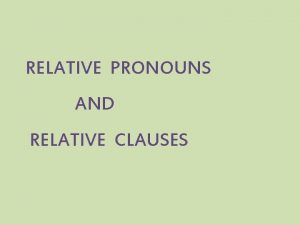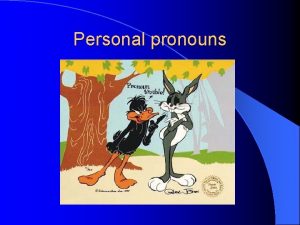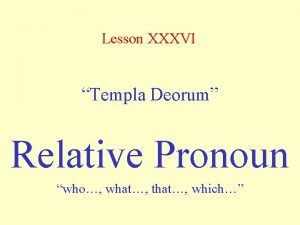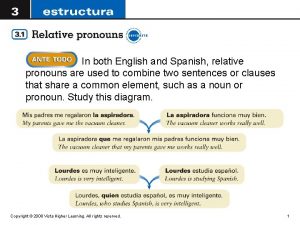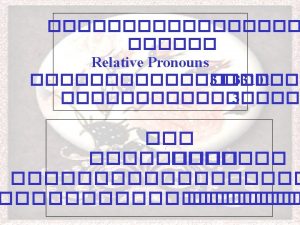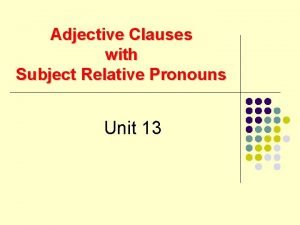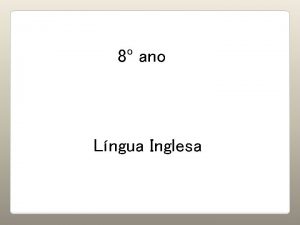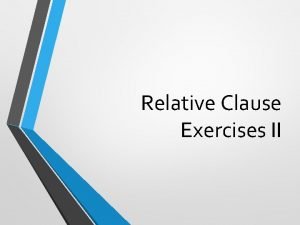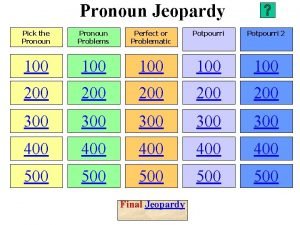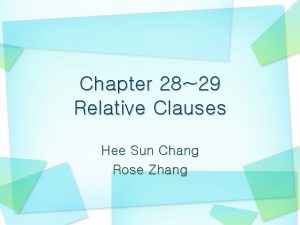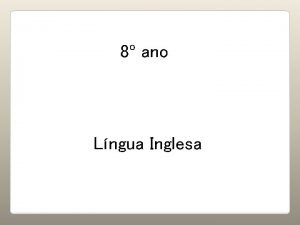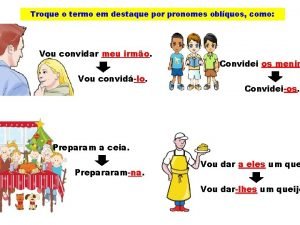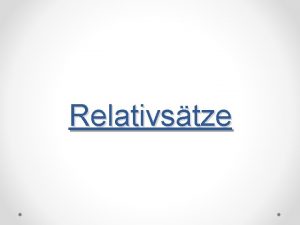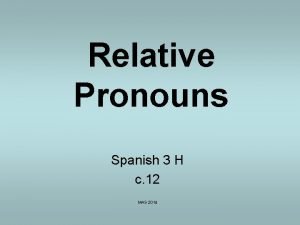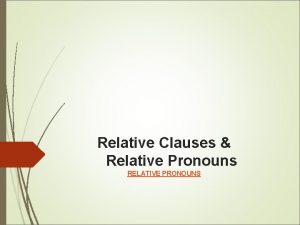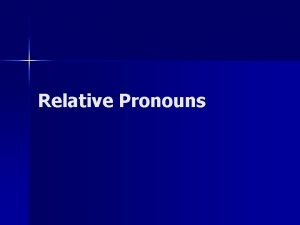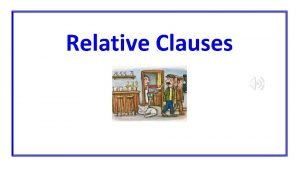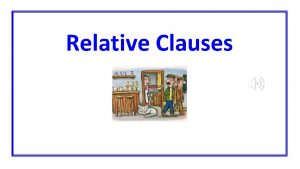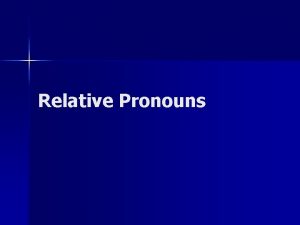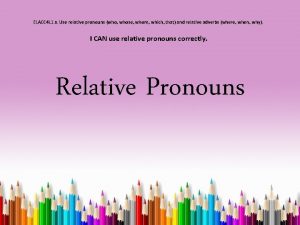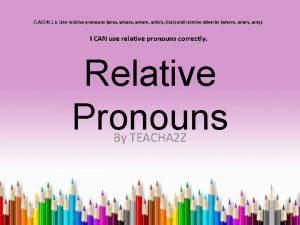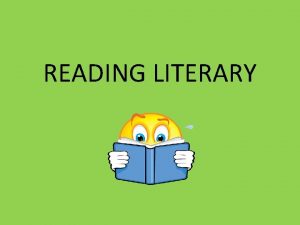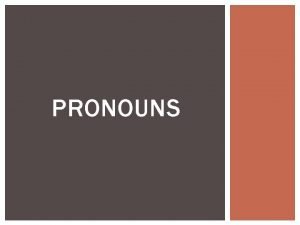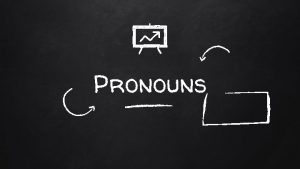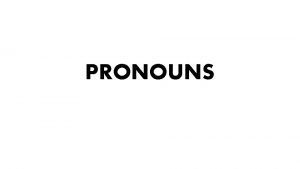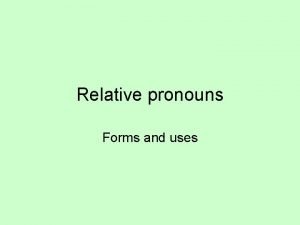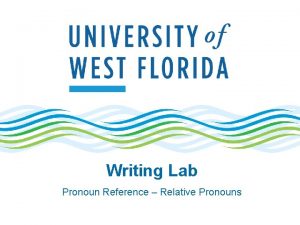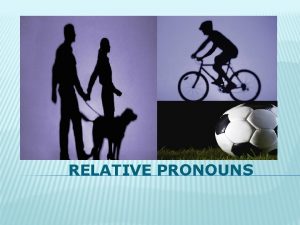ELACC 4 L 1 a Use relative pronouns

































- Slides: 33

ELACC 4 L 1 a. Use relative pronouns (who, whose, whom, which, that) and relative adverbs (where, when, why). I CAN use relative pronouns correctly. Relative Pronouns By TEACHA 2 Z

ELACC 4 L 1 a. Use relative pronouns (who, whose, whom, which, that) and relative adverbs (where, when, why). I CAN use relative pronouns correctly. Relative Pronouns Lesson 1 Who and Whom By TEACHA 2 Z

ELACC 4 L 1 a. Use relative pronouns (who, whose, whom, which, that) and relative adverbs (where, when, why). I CAN use relative pronouns correctly. Opening Meg is a girl. Meg likes ice cream. We can use a relative pronoun to make the sentences above into one sentence. Meg is a girl who likes ice cream. Click on the link below to hear a song about relative pronouns. Relative Pronouns Song - You. Tube

ELACC 4 L 1 a. Use relative pronouns (who, whose, whom, which, that) and relative adverbs (where, when, why). I CAN use relative pronouns correctly. Work Session A relative pronoun is a pronoun that introduces a relative clause. Relative pronouns “relate” to the word that it modifies or describes. We use relative pronouns after a noun to make it clear which person or thing we are talking about. There are five relative pronouns that we are going to focus on: who, whom, whose, which, and that.

ELACC 4 L 1 a. Use relative pronouns (who, whose, whom, which, that) and relative adverbs (where, when, why). I CAN use relative pronouns correctly. Work Session Let’s watch a short video to help us understand when to use “who” and “whom”. Who or Whom Video

ELACC 4 L 1 a. Use relative pronouns (who, whose, whom, which, that) and relative adverbs (where, when, why). I CAN use relative pronouns correctly. !! ! w e i ev Now ’s r t e l , Work Session Who is generally only used for people. Look at the following examples. • The girl ____ won the poster contest is in third grade. • The girl is in 3 rd grade. She won the poster contest. • The girl who won the poster contest is in 3 rd grade. he / she = who

ELACC 4 L 1 a. Use relative pronouns (who, whose, whom, which, that) and relative adverbs (where, when, why). I CAN use relative pronouns correctly. Whom is generally only use for people. Whom is not used very often. “Whom” is more formal than “who” and is often omitted when speaking. Look at the following examples. • • • She had three children, all of _______ went to Georgia Southern University. She had three children. All of them went to Georgia Southern University. She had three children, all of whom went to Georgia Southern University. Him / her / them = whom • • • We sometimes use whom as the object of a verb or preposition. This is Mrs. Garcia, whom you met at Open House. This is Mrs. Garcia’s sister, with whom I talked to over the phone. • When whom is used with a preposition, the preposition can be at the beginning or end of the clause. I have an aunt in Ireland, from whom I get my red hair. I have an aunt in Ireland, whom I get my red hair from. • •

ELACC 4 L 1 a. Use relative pronouns (who, whose, whom, which, that) and relative adverbs (where, when, why). I CAN use relative pronouns correctly. Work Session Model who Mr. Potter is the teacher ______ likes coffee. whom Guided Practice whom Mandy is the girl with _______ I play softball. whom who Jordan, _______ is now seven, just had a birthday. whom Independent Practice Complete the independent practice sheet for Lesson 1.

ELACC 4 L 1 a. Use relative pronouns (who, whose, whom, which, that) and relative adverbs (where, when, why). I CAN use relative pronouns correctly. Closing Create your own sentences with who and whom. Ask a friend what they like to do. Then use that information to write your own sentence with who or whom. For example: Rachel is my friend. She likes to ice skate. Rachel is my friend who likes to ice skate.

ELACC 4 L 1 a. Use relative pronouns (who, whose, whom, which, that) and relative adverbs (where, when, why). I CAN use relative pronouns correctly. Relative Pronouns Lesson 2 Who and Whose By TEACHA 2 Z

ELACC 4 L 1 a. Use relative pronouns (who, whose, whom, which, that) and relative adverbs (where, when, why). I CAN use relative pronouns correctly. Opening Watch the video clip on relative pronouns. “RELATIVE” PRONOUNS

ELACC 4 L 1 a. Use relative pronouns (who, whose, whom, which, that) and relative adverbs (where, when, why). I CAN use relative pronouns correctly. Opening Circle the relative pronoun found in the sentences below. Josh is a boy who loves to paint. He likes to stay inside when it is raining and draw and paint all day long.

ELACC 4 L 1 a. Use relative pronouns (who, whose, whom, which, that) and relative adverbs (where, when, why). I CAN use relative pronouns correctly. Opening Circle the relative pronoun found in the sentences below. Josh is a boy who loves to paint. He likes to stay inside when it is raining and draw and paint all day long. Who is the relative pronouns describing the boy. Who begins the relative clause “who loves to paint”.

ELACC 4 L 1 a. Use relative pronouns (who, whose, whom, which, that) and relative adverbs (where, when, why). I CAN use relative pronouns correctly. Work Session A relative pronoun is a pronoun that introduces a relative clause. Relative pronouns “relate” to the word that it modifies or describes. We use relative pronouns after a noun to make it clear which person or thing we are talking about. There are five relative pronouns: who, whom, whose, which, and that.

ELACC 4 L 1 a. Use relative pronouns (who, whose, whom, which, that) and relative adverbs (where, when, why). I CAN use relative pronouns correctly. Work Session Who is generally only use for people. Look at the following examples. • The girl ____ won the poster contest is in third grade. • The girl is in 3 rd grade. She won the poster contest. • The girl who won the poster contest is in 3 rd grade. he / she = who

ELACC 4 L 1 a. Use relative pronouns (who, whose, whom, which, that) and relative adverbs (where, when, why). I CAN use relative pronouns correctly. Work Session Whose is the only relative pronoun to show possession or ownership! Look at the following examples. • The man whose briefcase is on the seat left in a hurry. • The woman whose hair was in a mess is in the restroom.

ELACC 4 L 1 a. Use relative pronouns (who, whose, whom, which, that) and relative adverbs (where, when, why). I CAN use relative pronouns correctly. Work Session Model whose Students ______ parents are here get a homework pass. whose Guided Practice who Lance and Davion are the boys _______ went to the office for a prize. whose The police are looking for the car _____ owner ran the stop sign and caused the crash. whose Independent Practice Complete the independent practice sheet for Lesson 2.

ELACC 4 L 1 a. Use relative pronouns (who, whose, whom, which, that) and relative adverbs (where, when, why). I CAN use relative pronouns correctly. Closing Find My Mistake Activity You are the teacher. You are checking behind a new student teacher who has just checked a recent quiz. Is the student teacher correct? 1. The man who has on the sunglasses is my father. 2. The boy whose phone just rang is my brother. 3. The woman whose has on the red scarf is my mother. Go to the next slide to see if you are correct.

ELACC 4 L 1 a. Use relative pronouns (who, whose, whom, which, that) and relative adverbs (where, when, why). I CAN use relative pronouns correctly. Closing Find My Mistake Activity You are the teacher. You are checking behind a new student teacher who has just checked a recent quiz. Is the student teacher correct? 1. The man who has on the sunglasses is my father. 2. The boy whose phone just rang is my brother. 3. The woman whose has on the red scarf is my mother. The student teacher didn’t check number 3 correctly. It should say “The woman who has on the red scarf is my mother. ”

ELACC 4 L 1 a. Use relative pronouns (who, whose, whom, which, that) and relative adverbs (where, when, why). I CAN use relative pronouns correctly. Relative Pronouns Lesson 3 That, Who, and Which By TEACHA 2 Z

ELACC 4 L 1 a. Use relative pronouns (who, whose, whom, which, that) and relative adverbs (where, when, why). I CAN use relative pronouns correctly. Opening Let’s review!!! What are relative pronouns? How many can you name?

ELACC 4 L 1 a. Use relative pronouns (who, whose, whom, which, that) and relative adverbs (where, when, why). I CAN use relative pronouns correctly. Work Session A relative pronoun is a pronoun that introduces a relative clause. Relative pronouns “relate” to the word that it modifies or describes. We use relative pronouns after a noun to make it clear which person or thing we are talking about. There are five relative pronouns: who, whom, whose, which, and that.

ELACC 4 L 1 a. Use relative pronouns (who, whose, whom, which, that) and relative adverbs (where, when, why). I CAN use relative pronouns correctly. Work Session Which tells more about things. It is used when the clause added is unnecessary or nonessential to the sentences understanding. Notice the comma before the word which. Look at the following examples. Jacob went to the movies, which started at three o’clock. Tia ate a chocolate covered donut, which is full of sugar.

ELACC 4 L 1 a. Use relative pronouns (who, whose, whom, which, that) and relative adverbs (where, when, why). I CAN use relative pronouns correctly. Work Session That tells more about people or things. It is used when the clause added is necessary or essential to the sentence. Since the clause is essential, no comma is necessary. Look at the following examples. The pants that Tobi wore are too short. Lyra can not eat foods that contain too much sugar.

ELACC 4 L 1 a. Use relative pronouns (who, whose, whom, which, that) and relative adverbs (where, when, why). I CAN use relative pronouns correctly. Work Session Who is generally only use for people. Look at the following examples. • The girl ____ won the poster contest is in third grade. • The girl is in 3 rd grade. She won the poster contest. • The girl who won the poster contest is in 3 rd grade. he / she = who

ELACC 4 L 1 a. Use relative pronouns (who, whose, whom, which, that) and relative adverbs (where, when, why). I CAN use relative pronouns correctly. Work Session Model The woman _______ interviewed you is my boss. who which Guided Practice that She is wearing the kind of dress _____my mother would approve of. who that The couch, _________ is by the wall, needs repairing. which that which Independent Practice Complete the independent practice sheet for Lesson 3.

ELACC 4 L 1 a. Use relative pronouns (who, whose, whom, which, that) and relative adverbs (where, when, why). I CAN use relative pronouns correctly. Red Light / Green Light Activity Closing You need a green piece of construction paper and a red piece of construction paper. For each sentence that is correct, hold up the green piece of construction paper. For each sentence that is incorrect, hold up the red piece of construction paper. 1. This is the man which broke the window. 2. Katie is the only student who made an “A” on the test. 3. The house that is for sale has two bedrooms. 4. We had pizza, that is my favorite meal. 5. The little girl who won the spelling bee is pictured in the newspaper.

ELACC 4 L 1 a. Use relative pronouns (who, whose, whom, which, that) and relative adverbs (where, when, why). I CAN use relative pronouns correctly. Relative Pronouns Lesson 4 Who, Whom, Whose, That, Which By TEACHA 2 Z

ELACC 4 L 1 a. Use relative pronouns (who, whose, whom, which, that) and relative adverbs (where, when, why). I CAN use relative pronouns correctly. Opening Watch the video clip on relative pronouns. “RELATIVE” PRONOUNS

ELACC 4 L 1 a. Use relative pronouns (who, whose, whom, which, that) and relative adverbs (where, when, why). I CAN use relative pronouns correctly. Work Session A relative pronoun is a pronoun that introduces a relative clause. Relative pronouns “relate” to the word that it modifies or describes. We use relative pronouns after a noun to make it clear which person or thing we are talking about. There are five relative pronouns that we are going to focus on: who, whom, whose, which, and that.

ELACC 4 L 1 a. Use relative pronouns (who, whose, whom, which, that) and relative adverbs (where, when, why). I CAN use relative pronouns correctly. Work Session Model which Reece’s dog, ________ is a poodle, has a cute pink bow in its hair. whom that which Guided Practice who The police caught the thief _______ had been robbing houses in the neighborhood. whom that which This is Mr. Carswell, _______ you met last night at the Christmas party. whom that which that Gioia completed each problem _______ the teacher asked. whom that which

ELACC 4 L 1 a. Use relative pronouns (who, whose, whom, which, that) and relative adverbs (where, when, why). I CAN use relative pronouns correctly. Teacher For a Day Work Session HELP!!!! My jump drive with your test just crashed. I need you to help make more questions for the test. Think about the examples from the Work Sessions this week. Don’t forget to use a relative pronoun in each sentence. Be creative and have fun!!!!!

ELACC 4 L 1 a. Use relative pronouns (who, whose, whom, which, that) and relative adverbs (where, when, why). I CAN use relative pronouns correctly. Teacher For a Day Closing Share all of your wonderful sentences and questions with me so that I can make my test!!
 Elacc significato
Elacc significato Relative clauses and relative pronouns stage 15
Relative clauses and relative pronouns stage 15 Relative pronouns
Relative pronouns Relative adverbs examples
Relative adverbs examples Possessive
Possessive Demonstrative vs relative pronouns
Demonstrative vs relative pronouns Conditional frequencies
Conditional frequencies Who which that whose
Who which that whose Complete each sentence with a relative pronoun
Complete each sentence with a relative pronoun Relative pronoun in spanish
Relative pronoun in spanish Tipos de relative clauses
Tipos de relative clauses What is adjective clause
What is adjective clause Relativ pronouns
Relativ pronouns Join the sentences using relative pronouns
Join the sentences using relative pronouns Relative adverbs and pronouns
Relative adverbs and pronouns Pronouns in english
Pronouns in english Underline the relative pronouns
Underline the relative pronouns Voy a utilizar los platos 1 of 1 me regaló mi abuela.
Voy a utilizar los platos 1 of 1 me regaló mi abuela. Defining and non defining relative clause
Defining and non defining relative clause Decide whether the relative pronoun is correct or not
Decide whether the relative pronoun is correct or not Reduced relative clause example
Reduced relative clause example Relative pronouns exercicios
Relative pronouns exercicios Nonrestrictive adjective clauses
Nonrestrictive adjective clauses Adjective clause with object relative pronouns
Adjective clause with object relative pronouns Tirinha com relative pronouns
Tirinha com relative pronouns Relative clause rewrite exercise
Relative clause rewrite exercise Jeopardy pronouns
Jeopardy pronouns Relative pronouns jeopardy
Relative pronouns jeopardy Non-defining relative clauses
Non-defining relative clauses Relative pronouns rules
Relative pronouns rules Relative pronouns charles dickens
Relative pronouns charles dickens Mário cortou a grama
Mário cortou a grama Alle relativpronomen
Alle relativpronomen Spanish relative pronouns
Spanish relative pronouns
